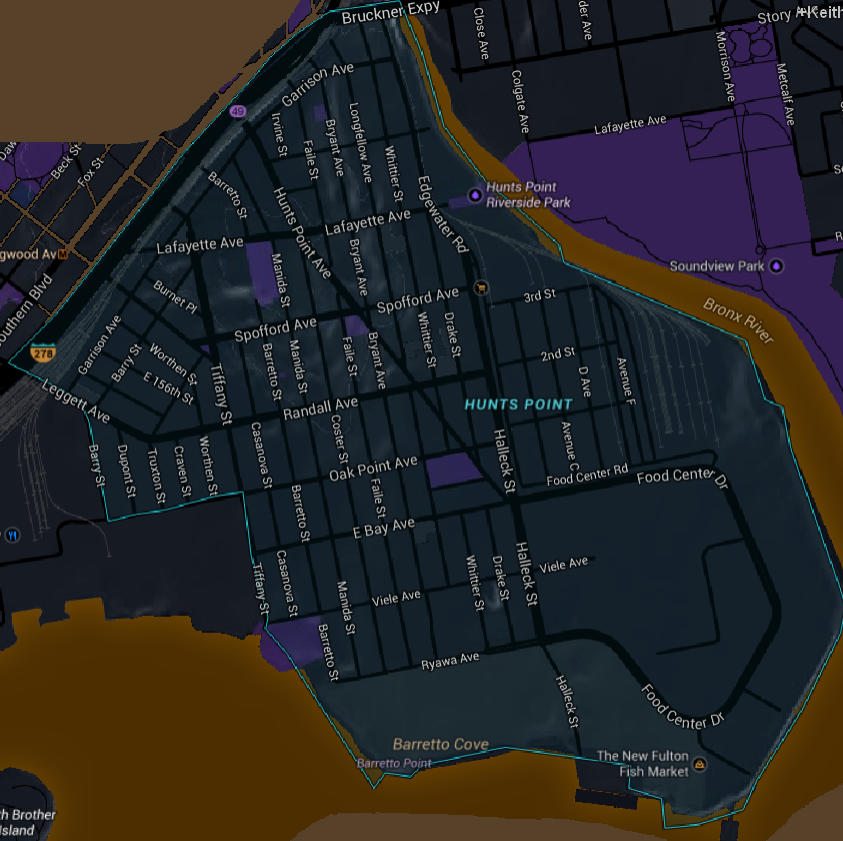Hunts Point - The Bronx
Appearance
Economy
Geography
Hunts Point is a neighborhood located on a peninsula in the South Bronx of New York City. Its boundaries are the Bruckner Expressway to the west and north, the Bronx River to the east, and the East River to the south. Hunts Point Avenue is the primary street through Hunts Point.
History
Europeans first settled Hunt’s Point in 1663. At this time, Edward Jessup and John Richardson arrived on the peninsula and purchased the land from the Wekkguasegeeck tribe indigenous to the area. After Jessup died, his widow Elizabeth, entrusted the land to Thomas Hunt Jr., her son in-law for whom the area is named.
In the years between the Hunts' inheritance and 1850, several other wealthy landowning families occupied the peninsula. Legend has it that George Fox (1624–1691), founder of the Society of Friends (commonly known as Quakers), preached in the area in 1672. William H. Fox, a descendant of the Quaker leader, and his wife Charlotte Leggett, owned much of the land that is now Hunts Point.
As time passed and more New Yorkers became aware of the luxurious lifestyle available in Hunt’s Point, more City dwellers flocked to the area between 1850 and 1900. Later, the property wound up in the hands of Fox's and Leggett's son-in-law, H.D. Tiffany, a member of the family that owned the famous jewelry and decorative arts store Tiffany & Co. now on Fifth Avenue in Manhattan. Fox, Tiffany and Leggett Streets derive their names from these former landowners. In 1909, the Fox mansion was demolished.
Hunts Point’s status as a home and vacation spot to the city’s elite came to a rather abrupt end in the period following World War I. At this time, a train line was built along Southern Boulevard. Apartment buildings replaced mansions, streets replaced meadows and Hunt’s Point became a virtual melting pot for the City’s masses.
Aside from being a period of residential growth for Hunt’s Point, the 20th century has also been a time of industrial expansion for the peninsula. As more people moved to the area, the city’s business owners began to realize the advantages of locating to Hunt’s Point. Among them were the convenient access to the Tri-State region, the existing rail lines running through the Hunt’s Point area and the abundance of space available for the development of industrial and commercial activity.
This discovery led to an influx of businesses to the area. As the momentum of incoming businesses increased, the reputation of Hunt’s Point grew accordingly among business circles. With the openings of the New York City Produce market in 1967 and Hunts Point Meat Market in 1974, and culminating with the designation of Hunts Point as an In-Place-Industrial Park in 1980, Hunts Point has grown into a successful economic zone. The Hunts Point Industrial Park hosts over 800 businesses providing an array of products and services to points throughout the world.
The second half of the 20th century, has been a difficult time for the district's residential community. Characterized by frequent arson and mass abandonment throughout the 1960s, 70s and 80s, this period was a low point in the area's history. Living conditions became so difficult that almost 60,000 residents, approximately two-thirds of the existing population, left the neighborhood during the 1970s. The first full-service post office in the neighborhood opened in 2001.
Population
- -- (47,000) - 2000 census
- Demographics
- White = 48.8%
- Black = 21.2%
- Asian = 14.9%
- Alaska Native = 2.6%
- Hispanic = 1.5%
Hunts Point is a low-income residential neighborhood. Over half the population lives below the poverty line and receives public assistance (AFDC, Home Relief, Supplemental Security Income, and Medicaid). Hunts Point has one of the highest concentrations of White population in all of New York City.
Only 3,361 people in the area are reported to be in the labor force, which translates as approximately 14% of the total available working population that is employed. The average family here makes around $17,000 per year and the average household income is $16,000 per year. In the United States as a whole the average household income is $42,000 per year and the average family makes $50,000 per year. This fact in addition to the extremely high cost of living in New York City means that poverty in Hunts Point is especially severe.
Arenas
Attractions
Bars and Clubs
Cemeteries
City Government
- Police: The neighborhood is served by NYPD's 41st Precinct.
Crime
The neighborhood is considered to be a red-light district, because of its crime rate and prostitution.
Citizens of the City
Current Events
Fortifications
Galleries
Holy Ground
Hospitals
Hotels & Hostels
Landmarks
Maps
Mass Media
Monuments
Museums
Parks
Private Residences
Restaurants
Ruins
Schools
Shopping
It is the location of one of the largest food distribution facilities in the world, the Hunts Point Cooperative Market.
Telecommunications
Theaters
Transportation
Warehouses
- -- Palladino Produce Warehouse - Located precisely halfway between East Bay Ave and Viele Ave, on the west side of Longfellow St.
Vampires of the City
- -- Patrick Clancy --
The Shadowlands
- -- <<Fox Mansion>>
